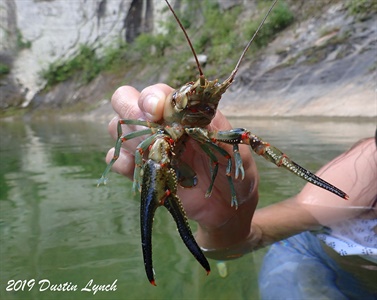Arkansans who have spent any time outdoors are quite familiar with crayfish (also called crawfish, crawdads, or mudbugs), whether it be catching a glimpse of the stream-dwelling species jetting off in a fast-flowing creek or finding the mud chimneys of the secretive burrowers that seem to appear overnight in backyards and roadside ditches. What most may not realize, however, is just how diverse our native crayfish fauna really is. Arkansas is home to approximately 60 species of crayfish found in nearly every kind of habitat where there is water either above or below the ground.
A lot of my work since starting as the aquatic ecologist at the ANHC in 2017 has been focused on studying these fascinating creatures. I’ve observed crayfish while on snorkeling surveys in clear highland streams in the Ozarks and Ouachitas, collected them from riffles while kick-seining from beautiful headwater creeks, set traps for them on summer evenings in cypress-tupelo swamps in the lowlands, excavated them from burrows on the remnants of the Grand Prairie, and even searched for them in caves deep below the earth. I’ve seen crayfish of every color, pattern, shape, and size. But if you asked me to name the single most impressive Arkansas crayfish, the one that I would show someone visiting the Natural State in order to leave a lasting impression, I would have to choose the Longpincered Crayfish (Faxonius longidigitus).
The Longpincered Crayfish is the largest species of crayfish occurring in Arkansas, and one of the largest in North America, regularly attaining a size of over 6 inches, and sometimes exceeding that length. It is endemic to the White River basin of northern Arkansas and southern Missouri, where it prefers to live in pools of highland streams along bluffs with large slabs of rock that provide crevices for shelter. Like most crayfish species, it is primarily nocturnal and omnivorous. It hides during the day and ventures out at dusk to prowl the bottoms of rocky pools while on the hunt for food. Dinner may consist of almost anything it can find, even other, smaller crayfish. It is an agile, strong swimmer that can be readily identified by its exceptionally long, slender pincers, which are blue-black in coloration with bright red tips.
I’ll never forget my first encounter with this species soon after moving to Arkansas for the first time in the spring of 2011 to begin my PhD research at the University of Arkansas. A lab mate took me to a site on War Eagle Creek to capture them. I had never seen such large and beautiful crayfish before. In turn, I couldn’t wait to show my field crew this species the following year in the crystal-clear waters of North Sylamore Creek, a place I have returned to see them time and again over the years.
Like many of our other stream-dwelling crayfish species, the continued existence of the Longpincered Crayfish is dependent on the conservation of clean, permanently flowing waters free of excessive pollution, nutrients, and siltation. Some of our state’s most iconic watersheds, such as the Buffalo National Scenic River, are home to this species. It is imperative that we protect these streams not only for our own enjoyment, but so that amazing aquatic species such as this one will continue to grace our state’s beautiful waterways.
